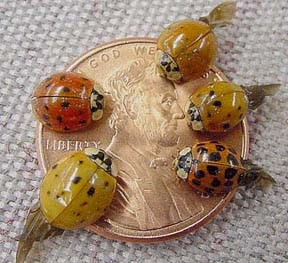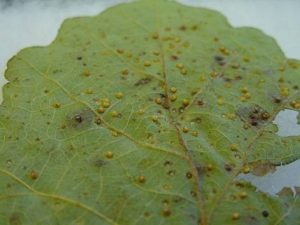
Multicolored Asian lady beetles (Photo Credit: Tim Gibb/Purdue Entomology)
Q. I have been wondering for several years why don’t we have any old-fashioned ladybugs? I know they disappeared about the same time Asiatic lady beetles appeared. I haven’t seen any info on this. and no one seems concerned about it. Is there no concern for an endangered species? Or is it only our area that they no longer seem to live in? – B.P., Orland, Indiana
A. There are thousands of species of lady beetles in the world, and about 400 of them can be found in the U.S.! The multicolored Asian lady beetle was introduced to the U.S. a few decades ago and has certainly been successful in colonizing here! While mostly beneficial in eating insect pests such as aphids, they also are a nuisance because they like to spend the winter months inside our homes. They can also occasionally feed on ripe fruits and release a rather unpleasant odor.
To the best of my knowledge, our native lady beetle species are still present, but not as noticeable since they are content to overwinter outdoors under leaf litter.
For more information on lady beetles, see the following articles from Purdue Entomology.
Some Lady Beetles Turn Out To Be Stinkers
Asian Lady Beetle
The ‘When’ in Asian Lady Beetle Control
Q. We have an oak tree that has these green, bumpy, ball-shape things on it. This summer, it is losing its leaves in clumps, and they have little bumps on them. Could you tell me what is going on? – B.H., Gentryville, Indiana

Jumping Oak Galls
Photo Credit: Cliff Sadof
Purdue Entomology
A. Plants often develop bumps or other odd growths that might remind one of a science-fiction movie, but there’s no need be alarmed. These unusual-appearing growths are called galls and are usually more of a cosmetic problem rather than a health crisis.
The galls themselves are mostly made up of plant tissue, usually from an attempt to recover from insect or disease injury. Galls can be quite small, just a fraction of an inch, or can be as large as several inches long, depending on the plant and cause of injury. Some of the most common landscape plants that develop galls include oaks, maples, hackberries and roses.
Although they may be unsightly, most galls occur on leaf tissue and are caused by insects but are nothing to be concerned about from a plant health standpoint.
Additional information on galls can be found in the following articles from Purdue Entomology.
Galls on Shade Trees and Shrubs
Jumping Oak Gall
Q. Could you advise me as to why the sweet gum trees are in such bad shape this spring? It seems that only the new growth has leafed out, leaving the rest of the tree pretty much bare. – L.S.
A. Like many other landscape plants, sweet gum is showing considerable winter injury this year throughout the northern half of the state. Many were very slow or failed to leaf out. In some cases, twigs leafed out but died back a bit later as summer heat stress came on.
Although this is the first time in my 30 years at Purdue that I’ve seen such widespread damage on sweet gum, this was a very extreme winter. It is quite common to see this type of damage to sweet gum in colder climates.
There’s not much you can do other than to prune out dead, damaged branches and hope that Mother Nature is gentler for the rest of this year.
More information on winter injury of 2014 is available at:
Purdue experts offer advice on plants damaged from harsh winter
The Revealing Effects of Winter on Trees and Shrubs